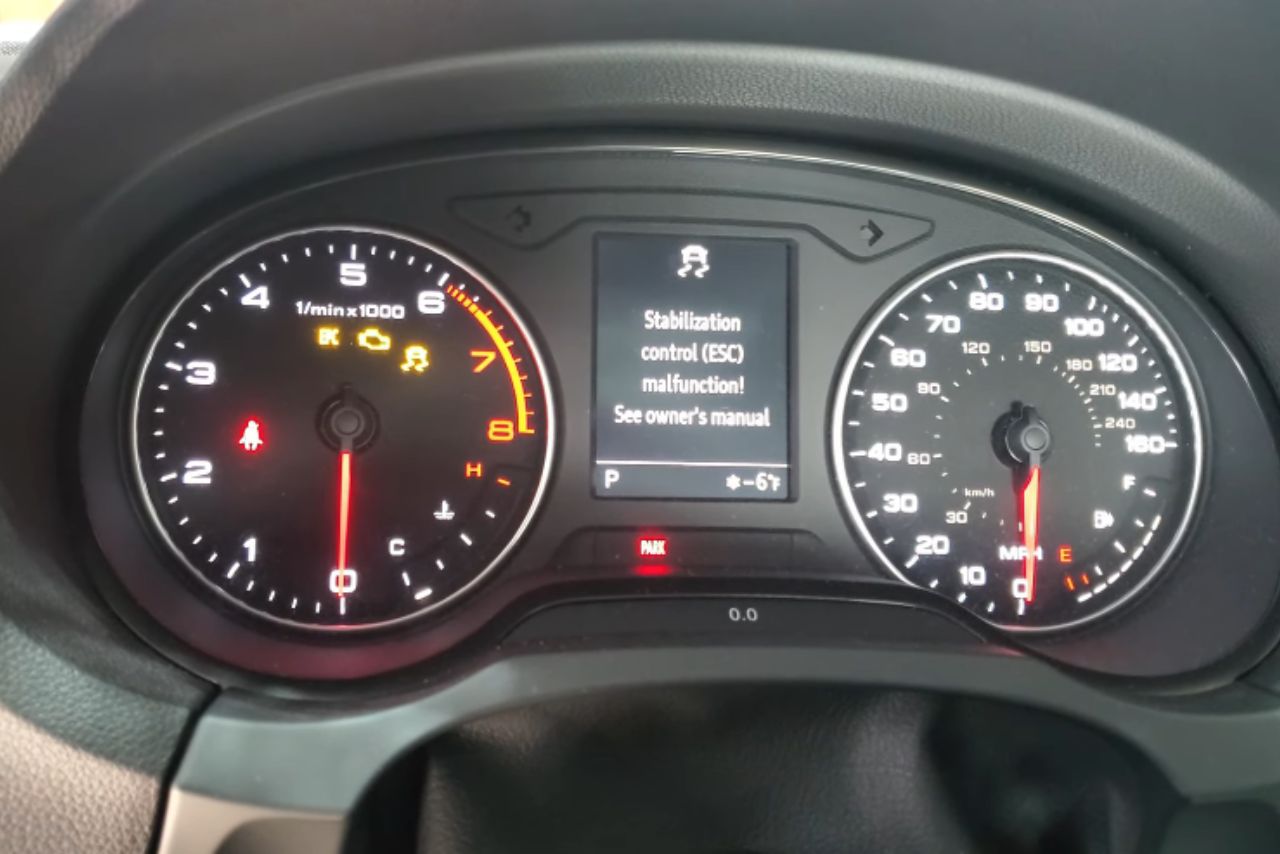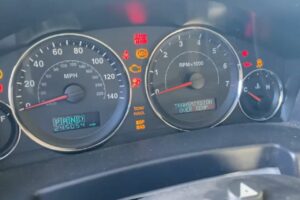If you’ve been behind the wheel of your Audi and noticed a sudden “Audi Stabilization Control Fault” or ESC error, you’re probably wondering what went wrong. Don’t fret!
This common issue is caused by various factors such as faulty sensors, wiring problems, or even software glitches in the Electronic Stability Control system itself.
But don’t worry – while some causes may sound serious, they can actually be fixed with good troubleshooting and sometimes simple DIY solutions.
This article will delve into the potential causes of Audi Stabilization Control faults and provide practical ways to address them effectively. So buckle up as we navigate through the intricacies of your car’s ESC system together!
Table of contents
What is Audi Stabilization Control?
Audi Stabilization Control, better known as Electronic Stability Control (ESC), is a crucial safety feature designed to increase the vehicle’s stability.

Here are some key components involved in this system:
| Component | Function |
|---|---|
| Sensors | These monitor various factors like wheel speed, direction of travel etc., providing real-time data to control unit. |
| Control Unit | Analyzes sensor data and determines if vehicle behavior matches driver inputs. |
| ActuatorsExecute commands from the control unit by applying brakes or reducing engine power as needed. |
Remember! Despite its sophistication and utility, ESC isn’t foolproof – drivers mustn’t over-rely on this technology at expense of safe driving habits.
Audi Stabilization Control Fault ESC Error Causes:
ESC, or Electronic Stability Control, is a crucial system in your Audi designed to enhance vehicle stability. When an error pops up, it could be due to several reasons:
In addition, let’s consider two more complex causes:
| Common Cause | Signs & Symptoms |
|---|---|
| Faulty Wheel Speed Sensors | Unusual tire wear patterns |
| Damaged Steering Angle | Difficulty steering |
| Problematic Brake Pressure | Uneven braking |
| Issues with ABS | Warning lights on dashboard |
| Problems with HCU | Inconsistent vehicle handling |
Understanding these causes will aid in troubleshooting an Audi Stabilization Control fault effectively.
Remember! Always consult a professional mechanic when dealing with vehicle electronic systems like the ESC since improper handling might worsen existing faults or create new ones.
Common Symptoms of ESC Errors:

If your Audi’s Electronic Stabilization Control (ESC) system encounters issues, you’ll likely notice the following symptoms:
Here are more specifics about each symptom in table format for ease of understanding:
| Symptom | Description |
|---|---|
| Dashboard Warning Light | An illuminated warning light often depicting a car with skid marks will appear on the dashboard |
| Loss of Vehicle Control | Reduced stability especially noticeable during fast turns or driving on slippery surfaces |
| Unusual Noises | Abnormal noises such as grinding or clicking when making a turn |
Remember, these signs don’t always mean there’s an issue with the ESC. They could be due to other underlying problems too. Always have your Audi checked by professionals if you notice any unusual behavior.
Watch this video to fix this issue ASAP:
Diagnostic Steps for Audi ESC Error:
When your Audi throws an ESC error, follow these steps:
Here’s a detailed breakdown of common causes and fixes associated with each code:
| Trouble Code | Possible Cause | Suggested Fix |
|---|---|---|
| U0073 | Faulty Control Module | Replace or repair module |
| P0500 | Defective Vehicle Speed Sensor | Replace speed sensor |
| P0571 | Brake Switch Malfunction | Check/replace brake switch |
Remember, some issues may require professional assistance. Always consult with a certified mechanic when in doubt.
Checking ABS Sensors for Faults:

Audi’s ESC (Electronic Stabilization Control) fault can be linked to issues with the ABS (Anti-lock Braking System) sensors. Let’s look at how you could check these sensors.
Further diagnostics will require specialized tools:
Here’s a quick overview of the process:
Using a Multimeter:
Using an OBD-II Scanner:
| If Code Shows | It Indicates |
|---|---|
| Sensor Circuit Open Or Shorted | Wiring issue or faulty sensor |
| Sensor Out Of Range | The signal is not within normal limits |
| No Signal From Sensor | The ECU isn’t receiving data |
These checks should help determine whether an ABS sensor is causing an ESC fault in your Audi. Consult professionals if unsure about performing these tasks yourself!
Inspecting Wheel Speed Sensors:
Wheel speed sensors play a crucial role in the Audi Stabilization Control system. They monitor wheel rotation speed and send this information to the ESC control unit. A fault in these sensors may trigger an ESC error. Here’s how to inspect them:
| Model | Front Sensor Resistance | Rear Sensor Resistance |
|---|---|---|
| Audi A4 | 1070-1210 Ω | 970-1130 Ω |
| Audi Q5 | 1000-1200 Ω | 980-1150 Ω |
If any issues are identified during inspection, replace faulty wheel speed sensor(s) immediately to rectify the ESC error.
Remember: always consult your vehicle manual or seek professional help when unsure about any procedures!
Examining Brake Pressure Sensor:
The brake pressure sensor plays a crucial role in the functioning of your Audi’s stabilization control system. An ESC error may occur if there is an issue with this sensor.
Here are some steps to examine and troubleshoot potential issues:
Locate the Sensor:
- Typically found near the master cylinder.
- Refer to your vehicle’s manual for exact location.
Check for Physical Damage:
- Look for visible signs of wear or damage.
Test the Sensor:
Inspect Wiring & Connections: Check wires leading to/from sensor.Ensure all connections are secure.
Scan For Error Codes: Use an OBD-II scanner
> Note: Specific codes might indicate issues with brake pressure sensor.
If problem persists after these checks, consider professional diagnosis or replacement of the brake pressure sensor.
Addressing Wiring and Connector Issues:
When dealing with an Audi Stabilization Control Fault, it’s crucial to address possible wiring and connector issues. Here are the steps you can take:
Inspect the Wiring: Look for any signs of damage on the wires connected to your ESC system.
Check Connector Plugs: Ensure they’re not loose or disconnected.
Issue Solution: Loose Plug Push firmly into socket Disconnected Plug Reconnect properly
Test Wire Continuity: Use a digital multimeter (DMM) to check if current flows through each wire without interruption.
Replace Damaged Parts: If you find any damaged wires or connectors, replace them immediately.
Remember, faulty wiring and connectors can cause serious problems in your Audi’s ESC system!
Fixing ESC Error with Software Update:
Fixing an Electronic Stabilization Control (ESC) error in your Audi could be as simple as a software update. Here’s how:
Visit the Dealer: It’s always best to let professionals handle it. They have access to proprietary software tools that aren’t available elsewhere.
Request a Diagnostic Check: The dealer will run a comprehensive diagnostic check on your vehicle, including the ESC system.
Ask for Updates: If there are any updates available for your car’s system, request them.
The points below shows what these steps entail:
By following these steps, you could potentially fix an existing or upcoming error within your Audi’s stabilization control unit without having to go through exhaustive repairs or replacements.
Replacing Faulty ESC Unit:
Facing an Audi Stabilization Control (ESC) unit fault? No worries. Here’s a simple guide to help you replace the faulty ESC unit:
Disconnect the Battery: Always start by disconnecting your car battery. This prevents electrical mishaps while working on your vehicle.
Locate the ESC Unit: In most Audis, it’s underneath the engine bay, mounted directly onto the power steering rack.
Unbolt and Remove Old Unit: Use a socket set and wrench to remove bolts holding old unit in place.
Replace with New Unit: Now, install new ESC unit where old one was located and bolt it into place properly.
Remember, if you’re not comfortable doing this yourself or don’t have necessary tools for replacement, always seek professional help!
What You Will Need:
Equipment Purpose:
Cost Estimate:
Replacing an Audi’s Stabilization Control system can range from $500-$1000 depending on labor costs in your area and price of part itself.
Conclusion and final thoughts 💭
Wrapping it up In the end, understanding the causes of an Audi Stabilization Control Fault can save you time and money.
It’s not just about turning off a pesky warning light on your dash; it’s about ensuring that your vehicle is safe and performs optimally.
Remember, simple fixes like checking tire pressure or resetting the system may resolve the problem.
However, if these steps don’t work, don’t hesitate to contact a professional mechanic for thorough inspection and repair. Vehicle safety should always come first.
Latest Posts:
- Can WD-40 Remove Scratches on Cars? (Hint: Yes, but…)
- Can You Use a Drill to Polish Your Car? (We Tried it Out!)
- Should You Cover Car Scratches With Stickers? (REVEALED!)
- Buick Service Stabilitrak: (Causes & 100% Guaranteed Fix!)
- Common Holden Trax Problems (Causes & 100% Proven Fixes!)
- Jeep Commander Transmission Over Temp: (Guaranteed Fix!)












Leave a Reply